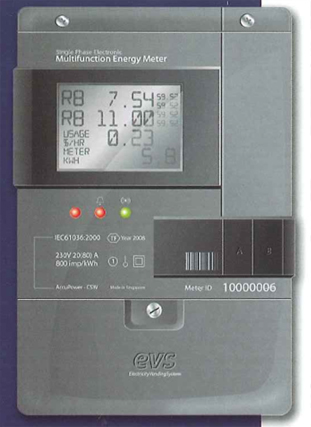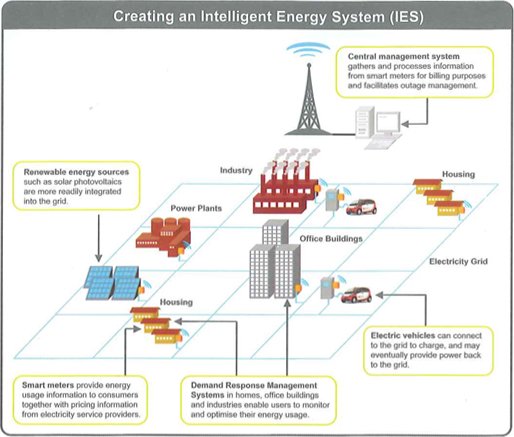Conventional electricity grids pose various challenges, not least of which is the inherent wastage in centralised generation models due to losses in conversion, transmission and distribution. Industrial and commercial users are generally "savvy" about consumption, and for the most part their usage patterns are steady and controlled.
Domestic consumption, however, tends to display high volatility, with sharp peaks and troughs. These challenges alone might underpin the case for a "smart grid" Add rising electricity prices, the need for energy security, growing levels of generation of intermittent renewable energy and the anticipated growth of electric vehicles, and it becomes clear that traditional grids must change if the world is to avoid energy rationing and power outages.
Evolving grid technologies
Smart grid initiatives are the focus of much attention, even as precise definitions of a "smart grid" remain the subject of debate and while standards for home gateways and other enabling technologies continue to evolve.
In the broadest sense, a smart grid might be defined as a grid which facilitates the balancing of energy supply, both on a national level and at a local level --and which supports a low-carbon energy infrastructure.
Key elements of the smart grid include demand response, load management, and customer engagement.

Forecasting accuracy for the supply side and informed usage on the consumer side both depend on real-time metering and an advanced metering infrastructure (AMI), or "smart meters". There are various projects around the world for smart meters and smart grids, including the ENEL smart meter programme in Italy, pilots in Austin, Texas, and the US$200 million Miami pilot that aims to deploy 1 million smart meters. Now, Singapore is joining this global programme.
Grid stability is not an issue in Singapore, which can boast one of the most reliable electricity networks in the world, with an average interruption time of less than one minute per customer per year. The Singapore grid already deploys advanced Supervisory Control and Data Acquisition (SCADA) systems with two-way communication channels, which can detect electricity supply disruptions automatically at the transmission and distribution level whenever they occur. Thus, Singapore is an ideal location to leverage on new technologies, bringing the capabilities of its power grid to the next level.

Intelligent Energy System pilot launched
In November 2009, the Energy Market Authority (EMA) of Singapore launched a pilot smart grid test programme, the Intelligent Energy System (IES), to develop and test new smart grid technologies and solutions. Singapore EMA Chief Executive Lawrence Wong describes the IES pilot project as a "living laboratory". The IES pilot seeks to test and evaluate new applications and technologies around a smart grid. It aims to integrate modern information and communication technology with the power system to allow two-way communication between electricity consumers and grid operators.
The IES will integrate an array of state-of-the-art information and communication technologies with the power infrastructure. The pilot project will see the installation of more than 4,500 smart meters in residential, commercial and industrial locations to test and evaluate workable solutions.
Eugene Toh, Deputy Project Director of the IES pilot project, says that a variety of components of a smart grid, including both grid side applications and consumer applications, will be developed and tested. Grid side applications include the installation of advanced metering and communications infrastructure that will enable the EMA to assess how smart meters can be connected through what Toh describes as "an appropriate communications network, be it fibre-optic cables, Wi-Fi or radio frequency". The various applications will permit both providers and consumers "to make more informed decisions about electricity usage".
With the IES enabling a two-way flow of communication between utilities and consumers, the EMA anticipates a growing role for outage management systems, which will allow for more effective monitoring and management of electricity outages. Singapore Power should be able to respond more quickly and more effectively to any power disruption. In addition, the pilot project seeks to smoothen the integration of a growing number of small and variable sources of power into the grid in a "plug-and-play" manner. In Singapore, localised generation sources include photovoltaic (PV) systems and small co-generation plants.
Customer other half of equation
But grid side applications are just one side of Singapore's smart grid equation: The role of the customer in managing electricity consumption is also key. The IES offers several potential benefits to customers. Through the use of smart meters, small consumers may select their electricity retailer and choose the package best suited to their needs.
Results from a proof-of-concept trial of smart meters and variable time-of-use electricity pricing early in 2009 were encouraging. More than 400 residents of Marine Parade and West Coast took part in this trial and were able to monitor household power consumption in real time through pager-like consumer display units. Combined with the implementation of time-of-use pricing, the trial achieved an average reduction of overall electricity consumption of 2.4 percent and a 3.9 percent reduction in peak usage. The trial clearly indicated the scope for incentivising customers to optimise consumption-- and save money for themselves -by shifting their consumption in line with time-related tariffs.
The IES offers the potential to build upon such gains by rolling out energy efficiency initiatives in households. Initiatives include the preprogramming of automation devices and smart meter appliances to function during off-peak hours when electricity prices are lowest. Commercial and industrial customers, as well as households, stand to gain from the roll-out of a suite of applications for the management of energy needs.
Toh points to automation systems that "monitor and control a building's lighting and mechanical systems". Wired to communicate with the grid, such systems will permit the owners and occupants of a building to participate in the demand response and energy efficiency programmes offered by the utility companies.
The pilot project is structured in two major phases.
Phased rollouts
The first phase involves the roll-out of infrastructure elements around the IES, building the enabling infrastructure to allow the deployment of a two-way data communications infrastructure using smart metering technology, as well as to enable demand response and outage management. Integration of distributed energy resources (DERs) and testing of electric vehicles to grid technologies will also be carried out at this stage. The EMA has shortlisted four major companies--IBM, Accenture, Logica and Siemens--to lead the consortium undertaking the first phase. A decision is expected later this year.
In the second phase of the pilot project, the emphasis will shift to the engagement between the EMA and real customers: phase two will involve the participation of households, as well as commercial and industrial consumers. These customers are spread out in various locations of Singapore, including the Nanyang Technological University, the newly established CleanTech Park and housing estates such as the Punggol Eco-Precinct. Electricity retailers will compete to offer time-varying electricity price tariffs and value-added services to consumers.
The pilot project also includes key Singapore government agencies such as the Infocomm Development Agency (IDA) and the Agency for Science, Technology and Research (A*STAR). The IDA is rolling out the Next Generation National Broadband Network--a high-speed fibre-optic network to all physical addresses in Singapore --and this is expected to form a critical communication infrastructure for the IES. The IES platform will complement A*STAR's research efforts in intelligent grids, which is being undertaken in its Experimental Power Grid Centre.
Smart meters trialed in selected households
The Housing & Development Board (HDB), Singapore's public housing authority, will also be closely involved. Smart meters are to be installed in households on estates such as the Punggol Eco-Precinct. And Singapore Power, through the market support services licensee SP Services and the grid operator SP PowerGrid, will play a major role at the level of infrastructure, facilitating both the customer side and grid side applications in the pilot project.
Singapore has recognised the potential role of smart grid technology to enhance the efficiency of electricity consumption by both domestic consumers and business customers, while accommodating other sources of power including distributed (embedded) generation and intermittent forms of renewable energy such as solar power. A reduction in consumer electricity consumption during peak periods looks set to bring two-fold benefits. Not only do consumers save on their electricity bills, but the lower peak demand will ease the pressure on generation plants -making for savings in terms of energy infrastructure spending for Singapore which, like many cities, is concerned with increasing energy consumption and the issue of energy security.
This "living laboratory" looks set to cultivate technologies and best practices, which will be applied in the future in electricity grids around the world.
Article reproduced with permission from Cleantech Magazine, a media partner of the Singapore International Energy Week 2010. The UK-based magazine focuses on the fast-growing cleantech space.
By : Dr Dennis Gross